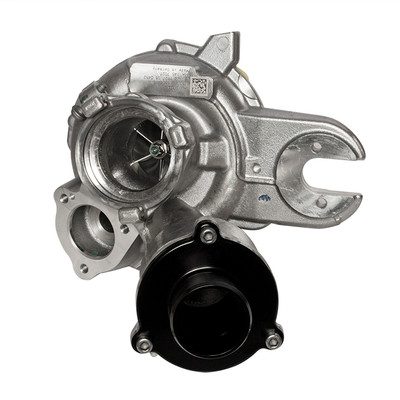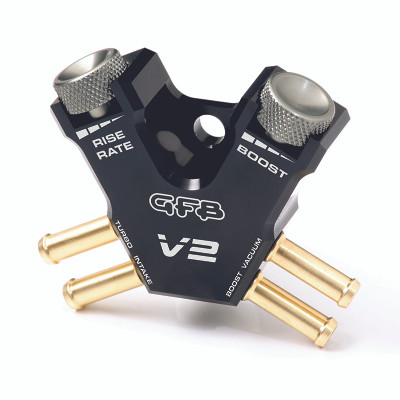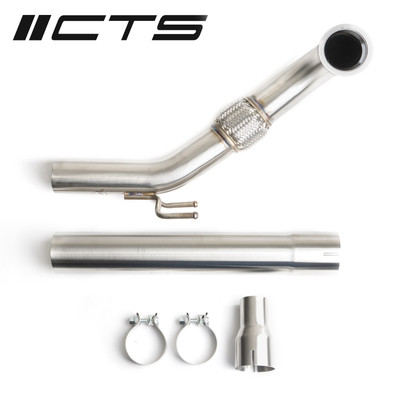You're on your way to ensuring your turbocharger is feeding your engine with all the boost! This is critical to keep the turbo and engine running properly and prevent a dangerous overspeeding situation where your turbo is trying to make up for lost air from a boost leak. This leads to turbo damage. Test your turbo motor with this kit and know everything is in check!
Works on all Vw AUDI 1.8T 20V engines excluding TT225 and any intake pipes running the larger 3" maf.
Design Features and components included:
-
2.75” O.D. End Cap with 1/8" NPT threaded gauge port & fitting port
-
Custom Stainless Steel 15 PSI / 1 Bar Boost Gauge
-
Universal Tire Schrader Valve
-
Stainless Steel T-Bolt Clamp
Considerations before you test:
-
Remove the oil cap to relieve any air pressure from accidentally entering into the crankcase ventilation system.
-
A 15 PSI gauge is provided with the kit since testing pre-turbo and the intake pipe is not designed to withstand higher pressures.
-
Plug included in this kit is required to be installed in place of the PCV “pancake” valve connection at the turbo intake pipe. Otherwise air pressure will just go into the crankcase.
-
Diverter valve diaphragm will need to be inspected separately since both sides of the inlet and outlet will be pressurized, it will not indicate a leak. This can easily be done with the thumb test. Push in the diaphragm valve, hold it, place thumb on vacuum nipple and hold it, then let go of the valve. If the valve falls back there is a leak. If it holds in its place, its good.
Very Common Air Leaks on the 1.8T
-
Any aftermarket connections
-
All Check valves, 3 way check valve that feeds the brake booster.
-
Lower intercooler hoses
-
All boost and vacuum lines
-
Diverter valve, use thumb test.
Basic Instructions Using this Boost Leak Tester:
-
Disconnect the turbo inlet hose “TIP” from the maf housing.
-
Install the tester directly onto the TIP and secure with the provided clamp. Ensure the cap & clamp are seated properly.
-
Disconnect the PCV air connection off the intake pipe and use provided plug and zip tie it. Some 1.8T models have the PCV valve connected directly on the TIP and some models have it near the valve cover. Either way, this connection will need to be plugged on the TIP to avoid air pressure from going into the crank case.
-
Remove the oil cap.
-
Pressurize the system with 5 PSI using the tire schrader valve fitting (if using the air fitting provided to regulate down your air compressor outlet).
-
Fix the first leaks if any found - move up to a higher pressure. If not obvious air leaks are found, use soapy spray on all connections.
-
Once you have fixed leaks, fill the system up to 10 PSI. cut off the pressure and watch the bleed rate of the system. The system should hold pressure well and a bleed rate of 1 PSI / second is normal. Minimal air is lost into the engine and makes its way into the crankcase ventilation. If the system is bleeding much faster than 1 PSI/second and there are no audible leaks, there may be a pcv check valve leaking into the crankcase. Inspect check valves and also see if systems ability to build pressure increases with oil cap on. This ensures there is a PCV leak from the boost pipes. Isolate and fix.
-
Do one final test after fixing all leaks verifying all leaks are addressed.
Congratulations, enjoy spooling the turbo with confidence!
Boost leak testing is an important factor in maintaining a turbo engine car. It should be routine maintenance similar to doing an oil change. Maybe not as frequently but it should be the first line of action with any modification or concern with the health of the motor. A boost leak test should be performed when any modification or upgrade is made to the air charge path. Upgrades like FMIC or charge pipe upgrades for example, may never see their full potential because a boost leak was left undetected from the install from a bad clamped connection, or whatever it might be. If going in for a custom tune, any good tuner will require a check for any boost leaks before strapping the car down to the dyno. It is critical not to tune in a boost leak. If so, and that leak does get fixed in the future with the same tune it will cause a lean condition. Replacing turbos is another time when a boost leak test is required since the boost leak may have been the root cause of the turbo failure.
Road race track days, street racing, drag racing - all are high demand situations for the motor and turbos - last thing you'll want is to put all that additional stress on the motor due to a boost leak.
Hoses, seals, gaskets, rubber, vacuum lines all deteriorate and fail with heat and age just like any other components that often get a lot of attention such as spark plugs, oil changes... A boost leak in any turbo motor can be just as detrimental as a worn or failed spark plug, injector or any other critical component in the engine. A boost leak in the charge path overworks the turbos. It will put stress on the entire system since the turbos need to overcome leak by overspeeding to make up for the loss of air and depending on severity of the leak, the turbo shaft bearings are compromised from a lack of lubrication leading to the shaft play and ultimately compressor and turbine wheel failure. Broken shafts, chewed up compressor wheels dumping aluminum pieces into the intake are examples of the worst case. In most cases the boost leaks are subtle undetected by the driver and do harm over time. This causes anomalies in the target air fuel ratios, higher ignition retard and other tuning related issues that unfortunately get blamed on the tune or tuner. Spinning turbos faster and out of their efficiency range puts a lot more heat into the intake, causing the ignition/spark retard, AFR's to be chasing the target AFR fuel since the expected air is not present due to the leak. The boost leaks, ignition spark timing, and AFR can act together in a synergy of stress on the motor.
Time after time we've seen stock and high horse-power cars come through that have done a visual check and confidently "tightened all the clamps down" to find something was leaking from a vacuum line or other overlooked connection. You can never be sure unless the system is pressurized! A smoke test is a good option for finding low pressure evap leaks but will never put the charge pipes to the test to detect higher boost leaks that surface above 10 PSI, 15PSI or even greater.
The good news is all this can be avoided with a simple boost leak test. The boost leak tester attaches to the turbo's compressor inlet, or in some cases, pre-turbo, and allows for a shop air compressor to pressurize the tester and all of the components while the engine is off. Including all hoses, clamped connections, diverter valve, one-way check valves, intercooler, intake manifold and manifold air connections, injector o-rings, PCV valves - all these components that the turbo normally pressurizes every single time its spooling to make full boost!
Spool the turbo with confidence and peace of mind!
































